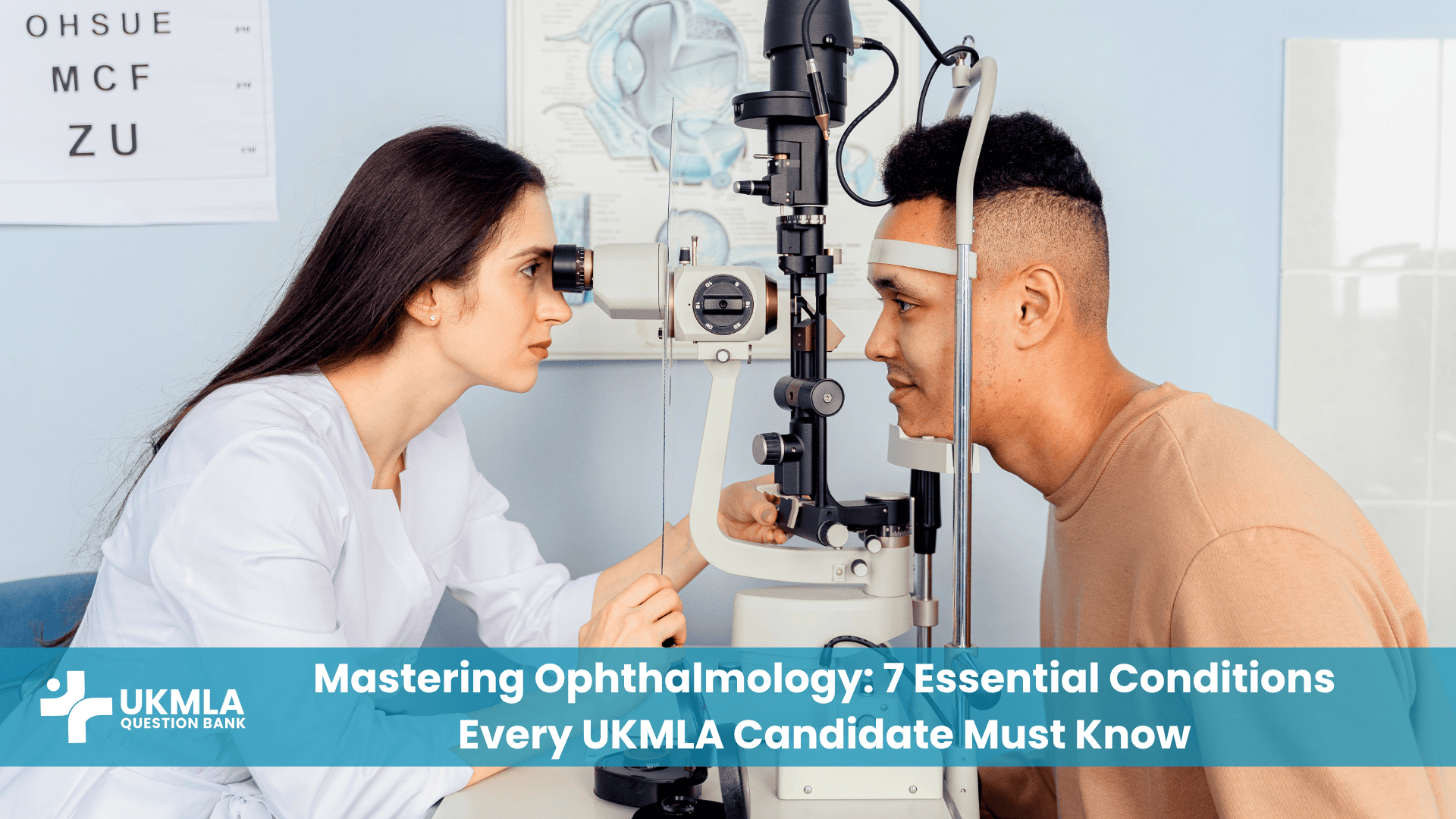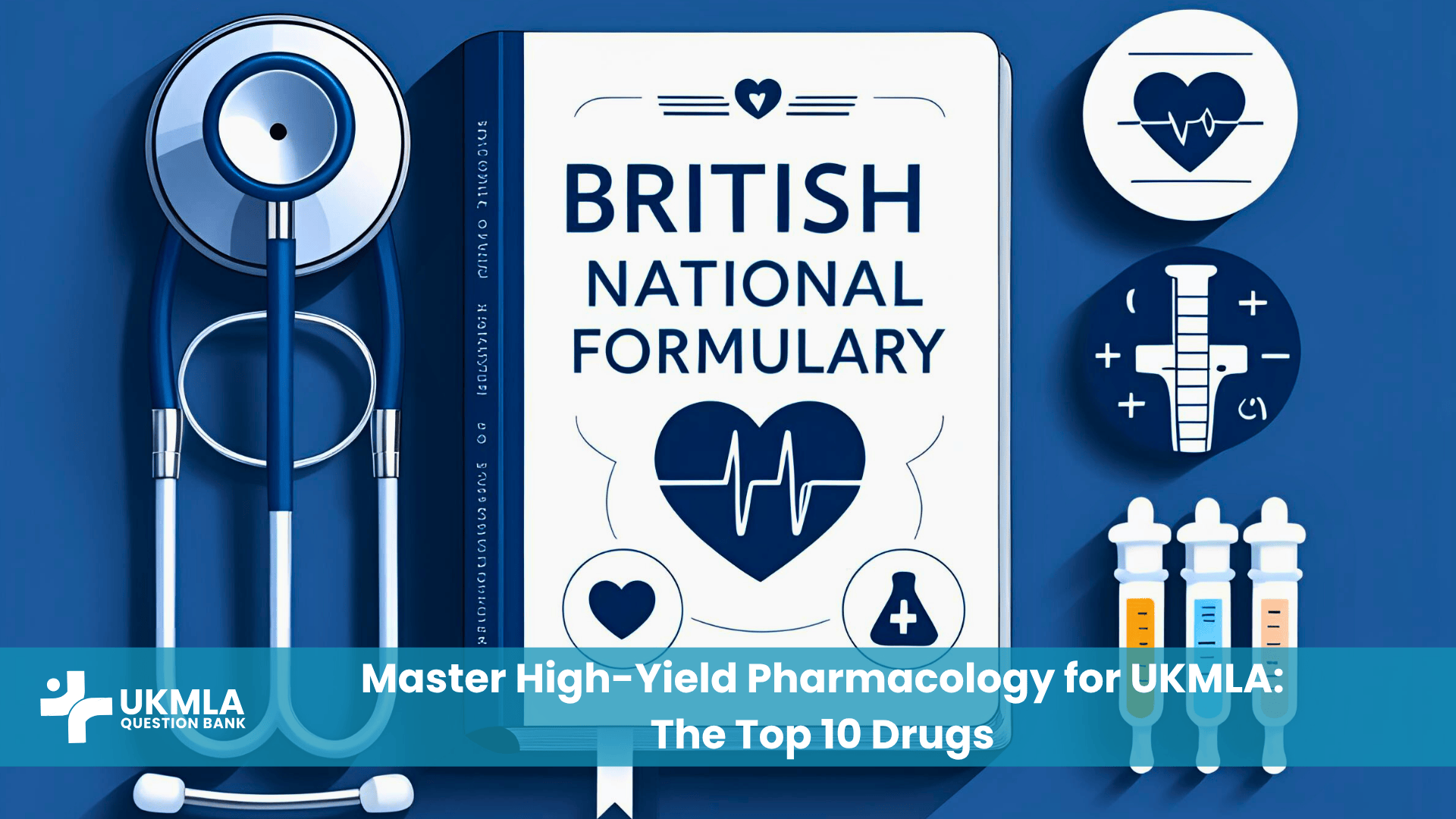Introduction
Ophthalmology, the branch of medicine dealing with the anatomy, physiology, and diseases of the eye, often strikes fear into the hearts of medical students and aspiring doctors. Its intricate anatomy, specialized examinations, and the critical nature of vision can feel overwhelming. Yet, for any UKMLA Ophthalmology Essential preparation, a solid understanding of core eye conditions is non-negotiable. Ophthalmology cases frequently appear in both the Applied Knowledge Test (AKT) as single best answer (SBA) questions and in the Clinical and Professional Skills Assessment (CPSA) as OSCE stations, often testing your ability to identify urgent “red flag” symptoms that demand immediate attention.
This comprehensive guide is designed to demystify ophthalmology for the UKMLA. We will distill the vast subject into 7 essential UKMLA Ophthalmology conditions that every candidate must know. For each condition, we’ll cover its key presentations, the crucial red flags that necessitate urgent action, and the initial management principles you need to grasp for safe practice. By mastering these high-yield topics, you’ll not only boost your exam performance but also build confidence in handling real-world ophthalmic emergencies. For a broader understanding of the examination structure, you may find our article on Understanding the UKMLA Exam Format particularly helpful. For insights into the educational standards for medical ophthalmology in the UK, refer to the GMC Medical Ophthalmology Curriculum.
Key Takeaways
Prioritize High-Yield: Focus study on the 7 essential conditions detailed here, as they represent frequently tested and clinically critical scenarios for UKMLA Ophthalmology Essential knowledge.
Master Presentations: Understand the classic symptoms and signs for each condition to aid rapid diagnosis.
Recognize Red Flags: Develop an immediate reflex for identifying ocular red flags that signal sight-threatening or life-threatening emergencies.
Grasp Initial Management: Know the immediate steps and appropriate referral pathways for urgent ophthalmic cases.
Systemic Links: Recognize that many eye conditions have systemic associations, requiring a holistic approach.
Why UKMLA Ophthalmology Essential Knowledge is Non-Negotiable for Success
Ophthalmology, despite being a specialized field, holds significant weight in the UKMLA. This isn’t merely about memorizing rare conditions; it’s about understanding common and crucial presentations, especially those that threaten vision or indicate systemic disease.
In the AKT, you’ll encounter scenarios where recognizing specific ophthalmic symptoms is key to selecting the correct diagnosis or initial management. For example, differentiating between a benign red eye and one indicating acute angle-closure glaucoma can be a make-or-break question. The exam tests your ability to synthesize information and identify patterns, often focusing on conditions that demand rapid intervention.
The CPSA (OSCE) stations might present you with a patient complaining of eye pain, vision loss, or a red eye. Your ability to take a focused history, identify red flags, perform a basic eye examination, and articulate appropriate initial steps and referrals is paramount. Missing an ophthalmic red flag in an OSCE could have significant implications for your “Readiness for Safe Practice” assessment, a core domain of the UKMLA. For more on this, consider reading our deep dive into A Deep Dive into the “Readiness for Safe Practice” Domain of UKMLA.
Ultimately, a strong grasp of UKMLA Ophthalmology Essential concepts demonstrates your capacity for safe clinical judgment, a fundamental requirement for GMC registration and practice in the UK.
Understanding Ocular Red Flags: When to Act Urgently
Identifying an “ocular red flag” is one of the most critical skills an aspiring doctor needs. These are signs and symptoms that indicate a potentially sight-threatening or, less commonly, life-threatening condition requiring immediate ophthalmological assessment and management. Delay can lead to irreversible vision loss.
Always keep these general red flags in mind, as they demand an urgent, often same-day, referral to an ophthalmologist:
Sudden, Painful Vision Loss: Suggests conditions like acute angle-closure glaucoma, optic neuritis, or corneal ulcer/keratitis.
Sudden, Painless Vision Loss: Points towards retinal detachment, central retinal artery/vein occlusion, or giant cell arteritis.
Pupillary Abnormalities: A fixed, mid-dilated pupil (acute glaucoma), or a relative afferent pupillary defect (RAPD) indicating optic nerve dysfunction.
Severe Pain (not just discomfort): Especially if accompanied by vision change or photophobia.
Chemical Injury to the Eye: Urgent irrigation is paramount before referral.
Penetrating Eye Injury/Open Globe Injury: Any suspicion warrants immediate, gentle shielding and urgent referral.
Proptosis (Bulging Eye) with Pain/Vision Change: Can indicate orbital cellulitis or a mass.
Persistent Diplopia (Double Vision): Especially sudden onset, can indicate neurological issues.
“Curtain” or “Shadow” Effect: Suggests retinal detachment.
Contact Lens Wearer with Red Eye & Pain: High suspicion for corneal infection.
Your role is often to recognize these signs and ensure prompt referral, not necessarily to manage complex ophthalmic conditions yourself.
The 7 Essential Ophthalmology Conditions for UKMLA Candidates
These 7 conditions are frequently tested in medical exams due to their high prevalence, potential for severe morbidity, or the critical importance of timely diagnosis and management. Mastering them is a UKMLA Ophthalmology Essential.
1. Acute Angle-Closure Glaucoma
Brief Overview: This is an ophthalmic emergency where the iris blocks the drainage angle of the eye, leading to a sudden, severe increase in intraocular pressure (IOP). This rapidly damages the optic nerve.
Key Presentations/Symptoms:
Sudden onset of severe eye pain, often described as a throbbing headache, typically unilateral.
Rapidly deteriorating, blurry vision in the affected eye.
Seeing halos around lights.
Nausea and vomiting (due to vagal stimulation from severe pain).
Redness of the affected eye, typically with ciliary injection (redness around the cornea).
On examination: The affected pupil is usually fixed and mid-dilated, unresponsive to light. The cornea may appear hazy or “steamy.” The eyeball may feel abnormally hard (rock-hard).
Red Flags: Unilateral, severe eye pain with sudden vision loss, fixed mid-dilated pupil, steamy cornea.
Initial Management Principles:
Urgent Ophthalmology Referral: This is paramount.
Position the patient supine (lying flat) to help move the lens-iris diaphragm posteriorly.
Pharmacological management (often administered by ophthalmology or under their guidance): Topical beta-blockers (e.g., Timolol), topical miotics (e.g., Pilocarpine), topical alpha-agonists (e.g., Apraclonidine), and systemic carbonic anhydrase inhibitors (e.g., Acetazolamide orally or IV) to reduce aqueous humor production. Osmotic agents like mannitol may also be used.
For comprehensive guidance, refer to the NICE guidance on Glaucoma: diagnosis and management (NG81).
2. Retinal Detachment
Brief Overview: A serious condition where the neurosensory retina separates from the underlying retinal pigment epithelium. If untreated, it can lead to permanent vision loss. Most commonly caused by a retinal tear (rhegmatogenous retinal detachment).
Key Presentations/Symptoms:
Sudden, painless monocular vision loss.
New onset of flashes of light (photopsia), often in the peripheral vision.
New onset of floaters (appearing as black dots, cobwebs, or a “shower of soot”).
A sensation of a “curtain,” “veil,” or “shadow” progressively moving across the visual field. This indicates the area of detached retina.
Red Flags: Sudden onset of flashes and floaters, especially if followed by a visual field defect; any “curtain” sensation.
Initial Management Principles:
Urgent Ophthalmology Referral: Surgical repair is typically required.
Keep the patient calm and comfortable. Avoid any activities that might increase intraocular pressure or cause further retinal tearing (e.g., straining, vigorous head movements).
Positioning: The patient may be advised to keep their head in a specific position to try and prevent further detachment while awaiting surgery.
3. Optic Neuritis
Brief Overview: Inflammation of the optic nerve, which transmits visual information from the eye to the brain. It is strongly associated with demyelinating diseases, most notably Multiple Sclerosis (MS).
Key Presentations/Symptoms:
Subacute monocular vision loss (develops over hours to days), often reaching its peak within a week.
Pain around or behind the eye, which is typically worse with eye movement.
Reduced color vision (dyschromatopsia), often more pronounced than the reduction in visual acuity. Patients may report colors appearing “washed out.”
Relative Afferent Pupillary Defect (RAPD) in the affected eye (Marcus Gunn pupil) – the pupil paradoxically dilates when light is swung from the unaffected to the affected eye.
Red Flags: Pain with eye movement, rapid vision loss, significant color desaturation, RAPD.
Initial Management Principles:
Urgent Ophthalmology/Neurology Referral: To confirm diagnosis and assess for underlying causes (especially MS).
Management often involves high-dose intravenous corticosteroids (e.g., methylprednisolone) which can hasten visual recovery but may not affect the final visual outcome. Investigation for MS (MRI brain, evoked potentials) is crucial. Refer to NICE guidance on Suspected neurological conditions: recognition and referral (NG127) for broader context on neurological assessment.
4. Bacterial Keratitis (Corneal Ulcer)
Brief Overview: A serious infection of the cornea, often leading to a painful ulcer. It is an ophthalmic emergency due to the risk of rapid vision loss and potential perforation. Contact lens wearers are at particularly high risk.
Key Presentations/Symptoms:
Severe eye pain, often sharp and constant.
Intense photophobia (sensitivity to light).
Marked redness of the eye (circumciliary injection).
Blurred or reduced vision.
Watery or purulent discharge.
History of contact lens wear (even overnight or extended wear) is a major risk factor.
On examination: A visible white or gray corneal infiltrate/ulcer, which stains with fluorescein. A hypopyon (pus in the anterior chamber) may be present in severe cases.
Red Flags: Contact lens use with any of the above symptoms, severe pain, central corneal infiltrate/ulcer.
Initial Management Principles:
Urgent Ophthalmology Referral: Immediate referral is essential.
DO NOT patch the eye. This can create a warm, moist environment conducive to bacterial growth.
Avoid topical anaesthetics for prolonged use, as they can hinder healing and mask symptoms.
Empiric broad-spectrum topical antibiotics, often hourly, should be started immediately by the ophthalmologist after corneal swabs (if possible).
5. Giant Cell Arteritis (GCA) / Temporal Arteritis
Brief Overview: A systemic vasculitis affecting medium- and large-sized arteries, most commonly the temporal artery. It is an absolute ophthalmic emergency because it can cause irreversible, often total, vision loss if not treated promptly. It primarily affects individuals over 50 years old.
Key Presentations/Symptoms:
Sudden, often painless, unilateral vision loss (amaurosis fugax or permanent vision loss). It can progress to bilateral vision loss if not treated rapidly.
New-onset, often severe headache, typically temporal (can be unilateral or bilateral).
Jaw claudication (pain in the jaw muscles when chewing).
Scalp tenderness (pain when touching the scalp or combing hair).
General systemic symptoms: Fatigue, fever, weight loss, night sweats.
Associated with polymyalgia rheumatica (aching and stiffness in shoulders and hips).
On examination: Temporal artery may be tender, prominent, or pulseless. Visual acuity may be severely reduced. Fundoscopy may show a pale, edematous optic disc.
Red Flags: Any new visual symptoms (especially vision loss) in a patient over 50 with new-onset headache, jaw claudication, or scalp tenderness.
Initial Management Principles:
MEDICAL EMERGENCY! Delay in treatment can lead to permanent bilateral blindness.
Immediate high-dose systemic corticosteroids (e.g., Oral Prednisolone 60mg-100mg daily or IV methylprednisolone for severe vision loss). Do not wait for lab results or biopsy.
Urgent Bloods: ESR (erythrocyte sedimentation rate) and CRP (C-reactive protein) are typically very high, but treatment should not be delayed if suspicion is high.
Urgent Temporal Artery Biopsy: Should be performed ideally within 1-2 weeks of starting steroids (as steroids can “cool off” the inflammation but biopsy is still useful). For further guidance on neurological symptoms, see NICE guidance on Suspected neurological conditions: recognition and referral (NG127).
6. Central Retinal Artery Occlusion (CRAO) / Central Retinal Vein Occlusion (CRVO)
Brief Overview: These are “strokes of the eye” resulting from blockages in the retinal blood supply. CRAO is typically due to an embolus, while CRVO is often linked to systemic vascular disease.
Key Presentations/Symptoms:
CRAO: Sudden, profound, painless monocular vision loss. Often described as a “curtain” coming down completely. On fundoscopy: a classic “cherry-red spot” at the macula (pale retina around a reddish fovea) and attenuated retinal arteries.
CRVO: Sudden or subacute, painless monocular vision loss. Usually less severe vision loss than CRAO. On fundoscopy: “blood and thunder” appearance (diffuse retinal hemorrhages, dilated tortuous veins, optic disc edema, cotton wool spots).
Red Flags: Sudden painless vision loss (especially total for CRAO), characteristic fundoscopic findings.
Initial Steps/Management:
Urgent Ophthalmology Referral: Essential for both.
CRAO (Emergency): While evidence is limited, immediate attempts to dislodge the embolus may be considered if within hours of onset (e.g., ocular massage, anterior chamber paracentesis by ophthalmologist, high-concentration oxygen).
Both CRAO and CRVO: Thorough systemic workup to identify underlying causes (e.g., hypertension, diabetes, hyperlipidemia, carotid artery disease, cardiac emboli, GCA for CRAO). Management focuses on preventing future vascular events. For more on neurological referral, see NICE guidance on Suspected neurological conditions: recognition and referral (NG127).
7. Diabetic Retinopathy / Hypertensive Retinopathy
Brief Overview: Microvascular damage to the retina caused by chronic uncontrolled diabetes (diabetic retinopathy) or hypertension (hypertensive retinopathy). Both are common and can lead to progressive vision loss.
Key Presentations/Symptoms:
Often asymptomatic in early stages.
Gradual blurring of vision, floaters, distorted vision.
Sudden, painless vision loss if severe (e.g., vitreous hemorrhage, retinal detachment, macular edema).
Diabetic Retinopathy: Microaneurysms, dot-blot hemorrhages, hard exudates, cotton wool spots (non-proliferative). Neovascularization, vitreous hemorrhage, tractional retinal detachment (proliferative).
Hypertensive Retinopathy: Arteriolar narrowing (“silver/copper wiring”), AV nipping, cotton wool spots, hemorrhages, optic disc edema (papilledema – sign of hypertensive emergency).
Red Flags: Known diabetes/hypertension with new/worsening visual symptoms, especially sudden onset. Signs of proliferative diabetic retinopathy or severe hypertensive retinopathy on fundoscopy. Papilledema is a medical emergency.
Initial Steps/Management:
Optimize Systemic Control: Crucial to control blood glucose, HbA1c, blood pressure, and lipids.
Regular Screening: Diabetic retinopathy requires regular screening for early detection.
Ophthalmology Referral: For laser photocoagulation, anti-VEGF injections (for macular edema or neovascularization), or surgery depending on severity.
Hypertensive Emergency: If papilledema is present due to hypertension, urgent reduction of BP is required.
For detailed guidance, refer to NICE guidance on Diabetic retinopathy: management and monitoring (NG242). You can also find relevant information on diabetes prevention from NICE guidance on Type 2 diabetes: prevention in people at high risk (PH38).
Differentiating Similar Clinical Presentations
Many ophthalmic conditions can present with overlapping symptoms, especially “red eye” or “vision loss.” Mastering the key discriminators is an UKMLA Ophthalmology Essential.
| Symptom/Sign | Conjunctivitis | Acute Angle-Closure Glaucoma | Bacterial Keratitis | Acute Anterior Uveitis | Scleritis |
| Pain | Gritty, itchy | Severe, deep, throbbing headache | Severe, sharp, foreign body sensation | Moderate to severe, aching | Severe, boring pain, often radiating to face/head, worsened by eye movement, tenderness on palpation of globe. |
| Vision | Normal to slightly blurred | Markedly reduced, halos | Reduced, blurred | Reduced, blurred | Normal, unless associated keratitis/uveitis. |
| Redness | Diffuse, prominent conj. redness | Ciliary injection (around cornea) | Ciliary injection | Ciliary injection | Deep, violaceous redness (sectoral or diffuse), often with localized tenderness. Vessels do not blanch with phenylephrine drops. |
| Pupil | Normal | Fixed, mid-dilated | Normal | Small, irregular (due to synechiae) | Normal |
| Photophobia | Mild | Present | Marked | Marked | Moderate to severe. |
| Discharge | Watery/purulent | None (or watery tears) | Purulent | None | None. |
| Cornea | Clear | Hazy/Steamy | Infiltrate/Ulcer, stains +ve | Clear (unless keratitis) | Clear (unless associated peripheral ulcerative keratitis which is common). |
| IOP (Intraocular Pressure) | Normal | Very High (>40 mmHg) | Normal or elevated | Normal or slightly low | Normal or slightly elevated. |
Applying Your Ophthalmology Knowledge to the UKMLA Exam
Knowing the conditions is one thing; applying that knowledge under exam conditions is another.
AKT Strategies: How to Tackle SBAs
For ophthalmology SBAs, focus on:
Keywords & Red Flags: Identify the classic symptom complexes (e.g., “fixed mid-dilated pupil,” “jaw claudication,” “flashes and floaters”). These are often the key to the diagnosis.
Age & Risk Factors: Patient age (e.g., >50 for GCA), contact lens use, diabetes, hypertension are crucial context.
Initial Management: Questions frequently test the immediate most appropriate step – often urgent referral or starting life/sight-saving treatment (e.g., steroids for GCA).
Differential Diagnosis: Be prepared to rule out similar-presenting conditions based on subtle differences (e.g., pain vs. painless vision loss).
For more on question strategies, see UKMLA AKT: How to Tackle Single Best Answer (SBA) Questions Effectively.
CPSA (OSCE) Application: Clinical Scenarios
In an ophthalmology OSCE station, you might encounter a patient with an eye complaint. Your approach should be:
Focused History: Ask about onset, duration, pain (type, severity, radiation), vision changes (sudden/gradual, full/partial), associated symptoms (headache, nausea, flashes, floaters), relevant past medical history (diabetes, hypertension, autoimmune conditions), and social history (contact lenses, occupation).
Targeted Examination: Perform relevant parts of a basic eye exam (visual acuity, pupillary reactions including RAPD, eye movements, external eye inspection). Do not attempt fundoscopy unless explicitly asked or deemed appropriate for the scenario.
Red Flag Identification: Articulate to the examiner any red flags you identify and why they warrant urgent action.
Safety Netting: Advise the patient on what symptoms to look out for and when to seek immediate medical attention.
Appropriate Referral: Clearly state your initial management plan, emphasizing the need for urgent ophthalmology review where indicated.
For detailed guidance, consult UKMLA CPSA Explained: Format, Stations, and Assessment Criteria.
Frequently Asked Questions (FAQ) Your UKMLA Ophthalmology Questions Answered
The most high-yield ophthalmology topics for the UKMLA typically include acute vision loss (painful and painless), red eye differentials, common systemic diseases affecting the eye (like diabetes and hypertension), and ophthalmic emergencies such as acute angle-closure glaucoma, retinal detachment, and giant cell arteritis. Focusing on conditions that require urgent recognition and referral is key.
While ophthalmology isn’t a primary specialty area like Internal Medicine or Surgery, it is consistently integrated throughout the UKMLA. You can expect to encounter ophthalmology questions in the AKT (Applied Knowledge Test) as SBA questions testing diagnosis and initial management, and potentially as clinical scenarios in the CPSA (Clinical and Professional Skills Assessment) OSCE stations. It’s often tested as “red flag” conditions where quick recognition is critical for patient safety.
An ophthalmic “red flag” is a symptom or sign that indicates a potentially sight-threatening or, less commonly, life-threatening condition requiring immediate medical attention. Examples include sudden, profound vision loss (painful or painless), severe eye pain, fixed or abnormal pupil reactions, chemical eye injuries, or a “curtain” coming across vision. Recognizing these is crucial for urgent referral.
Acute angle-closure glaucoma is an emergency, while conjunctivitis is generally not. Key differentiators include:
Pain: Glaucoma causes severe, deep eye pain and headache; conjunctivitis causes gritty discomfort or itchiness.
Vision: Glaucoma causes marked vision loss and halos; conjunctivitis usually has normal or mildly blurred vision.
Pupil: Glaucoma has a fixed, mid-dilated pupil; conjunctivitis has normal pupils.
Cornea: Glaucoma often has a hazy/steamy cornea; conjunctivitis has a clear cornea.
Nausea/Vomiting: Common with glaucoma due to severe pain; absent in conjunctivitis.
A “cherry-red spot” is a classic fundoscopic finding seen in Central Retinal Artery Occlusion (CRAO). It appears as a pale, edematous retina (due to ischemia) with a reddish fovea (macula), where the choroidal blood supply remains visible. It signifies a complete blockage of the central retinal artery, leading to profound, sudden, painless vision loss. It’s a medical emergency requiring urgent ophthalmology consultation.
As a Foundation Doctor (FY1/FY2), your role in eye emergencies primarily involves recognizing red flags, initiating appropriate first-aid (e.g., eye irrigation for chemical burns, shielding for penetrating injuries), taking a focused history, performing basic relevant examinations, and most importantly, making prompt and appropriate urgent referrals to the ophthalmology team. You are not expected to manage complex ophthalmic conditions independently.
Many systemic diseases have ocular manifestations. Key examples include:
Diabetes Mellitus: Can cause diabetic retinopathy, cataracts, glaucoma.
Hypertension: Can cause hypertensive retinopathy.
Autoimmune Diseases (e.g., Rheumatoid Arthritis, SLE, Ankylosing Spondylitis): Can cause uveitis, scleritis, dry eyes.
Thyroid Eye Disease (Graves’ Disease): Causes proptosis, diplopia, vision loss.
Multiple Sclerosis: Strongly associated with optic neuritis.
Vascular Diseases (e.g., Atherosclerosis): Can lead to retinal artery/vein occlusions, amaurosis fugax.
Infections: Can affect various parts of the eye (e.g., viral conjunctivitis, bacterial keratitis).
To prepare for ophthalmology OSCEs, focus on:
Focused History Taking: Practice asking key questions for common eye complaints.
Basic Eye Exam: Master visual acuity (Snellen chart), pupillary examination (including RAPD), eye movements, and external eye inspection.
Red Flag Recognition: Be able to verbalize identified red flags and their significance.
Communication Skills: Practice explaining conditions, safety netting, and referral plans clearly to a simulated patient.
Practice Scenarios: Use OSCE textbooks or online resources for common ophthalmology stations.
For UKMLA Ophthalmology Essential revision, combine:
Medical Textbooks/Online Resources: e.g., Oxford Handbook of Clinical Medicine, specific ophthalmology chapters.
Official Guidelines: NICE (National Institute for Health and Care Excellence) guidelines for common conditions.
UKMLA Question Banks: Crucial for applying knowledge and identifying high-yield areas.
Flashcards/Active Recall: For memorizing presentations, red flags, and management steps.
OSCE Practice Videos: To visualize and practice clinical examination and communication skills.
A Relative Afferent Pupillary Defect (RAPD), also known as a Marcus Gunn pupil, is a sign of asymmetric optic nerve or retinal disease. When light is swung from the unaffected eye to the affected eye, the affected pupil paradoxically dilates or remains static, rather than constricting further. This indicates that the affected eye’s optic nerve is not sensing the light stimulus as strongly as the other eye. It is a key clinical sign in conditions like optic neuritis, severe retinal detachment, or large retinal artery/vein occlusions.
Conclusion: Your Pathway to UKMLA Ophthalmology Mastery
Mastering Ophthalmology for the UKMLA is not about becoming an eye specialist; it’s about developing the clinical acumen to recognize critical eye conditions, differentiate them from less serious ones, and act appropriately to preserve vision and overall patient well-being. By focusing on these 7 essential UKMLA Ophthalmology conditions – Acute Angle-Closure Glaucoma, Retinal Detachment, Optic Neuritis, Bacterial Keratitis, Giant Cell Arteritis, CRAO/CRVO, and Diabetic/Hypertensive Retinopathy – you’ll build a robust foundation.
Your ability to identify red flags and initiate timely referrals is a core component of safe practice, heavily tested in the UKMLA. Consistent revision, coupled with practical application of this knowledge, will significantly enhance your confidence and performance.
Ready to Master Your UKMLA?
The best way to solidify your UKMLA Ophthalmology Essential knowledge is through practice. Apply what you’ve learned to real exam-style questions.
Start integrating these strategies into your study routine today! Explore our UKMLA Question Bank: An Essential Resource for Medical Aspirants and start practicing with hundreds of high-yield questions to reinforce your learning and accelerate your path to UKMLA success.




